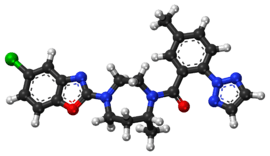Suvorexant
 | |
 | |
| Systematic (IUPAC) name | |
|---|---|
|
[(7R)-4-(5-chloro-1,3-benzoxazol-2-yl)-7-methyl-1,4-diazepan-1-yl][5-methyl-2-(2H-1,2,3-triazol-2-yl)phenyl]methanone | |
| Clinical data | |
| Trade names | Belsomra |
| AHFS/Drugs.com | entry |
| MedlinePlus | a614046 |
| Pregnancy category |
|
| Legal status |
|
| Routes of administration | By mouth |
| Pharmacokinetic data | |
| Bioavailability | 82% (at 10 mg) |
| Protein binding | >99% |
| Metabolism | hepatic, CYP3A, CYP2C19 |
| Biological half-life | ~12 hours |
| Excretion | Feces (66%), urine (23%) |
| Identifiers | |
| CAS Number |
1030377-33-3 |
| ATC code | None |
| PubChem | CID 24965990 |
| IUPHAR/BPS | 2890 |
| ChemSpider |
4589156 |
| UNII |
081L192FO9 |
| ChEMBL |
CHEMBL1083659 |
| Synonyms | MK-4305 |
| Chemical data | |
| Formula | C23H23ClN6O2 |
| Molar mass | 450.92 g/mol |
| |
| |
| | |
Suvorexant, sold under the trade name Belsomra, is a medication for the treatment of insomnia.[1] It is effective for insomnia, at least for four weeks and as compared to a placebo.[2]
Suvorexant is a selective, dual orexin receptor antagonist made by Merck & Co. It was approved for sale by the U.S. Food and Drug Administration (FDA) on August 13, 2014.[3] The U.S. Drug Enforcement Administration (DEA) has placed it on the list of schedule IV controlled substances.[4] The drug became available in Japan in November 2014[5] and in the United States in February 2015.[6]
Medical uses
Suvorexant is used for the treatment of insomnia, characterized by difficulties with sleep onset and/or sleep maintenance.[7]
It is unclear how this medication compares to others used for insomnia as no comparisons have been done.[2] It is also unclear if this medication is safe among people with a history of addiction, as they were excluded from the clinical trials of suvorexant.[2]
Special populations
This drug is not recommended in people with liver impairment.[8] Suvorexant pregnancy category is currently classified as Category C.[9] Based on animal testing, this medication may cause fetal harm during pregnancy and should only be given in pregnancy if the potential benefit justifies the potential harm to the fetus. Evidence is inconclusive about whether using this medication while breastfeeding puts the infant at risk of harm.[8]
Contraindications
Suvorexant is contraindicated in people diagnosed with narcolepsy.[9]
Side effects
Issues include sleepiness the next day and issues with driving.[10] Other concerns include unusual dreams and thoughts of suicide.[10]
There have been reports of people performing complex tasks (such as cooking and eating, making phone calls, driving, having sex) with little recollection of the events after taking suvorexant.[11]
Interactions
Suvorexant is not recommended if people are also taking medications that strongly inhibit the liver enzyme CYP3A like itraconazole, lopinavir/ritonavir, clarithromycin, ritonavir, ketoconazole, indinavir/ritonavir, or conivaptan.[8][12] If this medication is used with medication that moderately inhibit the liver enzyme CYP3A, like verapamil, erythromycin, diltiazem, or dronedarone, it is recommended that the dose of suvorexant be adjusted.[8][12]
Mechanism of action
Suvorexant exerts its therapeutic effect in insomnia through antagonism of orexin receptors. The orexin neuropeptide signaling system is a central promoter of wakefulness. Blocking the binding of wake-promoting neuropeptides orexin A and orexin B to receptors orexin receptor type 1 (OX1) and orexin receptor type 2 (OX2) is thought to suppress wake drive.[7] Animal studies report the binding affinities for OX1 (0.55 nM) and OX2 (0.35 nM).[13]
Pharmacokinetics
The bioavailability of suvorexant is at 82%. It is highly protein-bound. Food delays the time to max concentration. Suvorexant is extensively metabolized by the liver. Suvorexant is renally excreted (23% unchanged) and through feces (66% unchanged). The elimination half-life is reported to be 12 hours.[9]
Abuse liability
According to the U.S. Drug Enforcement Administration (DEA), suvorexant produces similar reinforcing effects to those of zolpidem in humans and thus may have a similar abuse liability.[14] As such, suvorexant has been designated a schedule IV controlled substance in the U.S. under the Controlled Substances Act.[14]
See also
References
- ↑ Baxter, C. A.; Cleator, E.; Brands, K. M. J.; Edwards, J. S.; Reamer, R. A.; Sheen, F. J.; Stewart, G. W.; Strotman, N. A.; Wallace, D. J. (2011). "The First Large-Scale Synthesis of MK-4305: A Dual Orexin Receptor Antagonist for the Treatment of Sleep Disorder". Organic Process Research & Development 15 (2): 367–375. doi:10.1021/op1002853.
- 1 2 3 "Suvorexant: A Dual Orexin Receptor Antagonist for the Treatment of Sleep Onset and Sleep Maintenance Insomnia.". Ann Pharmacother 49: 477–483. Feb 9, 2015. doi:10.1177/1060028015570467. PMID 25667197.
- ↑ http://www.fda.gov/NewsEvents/Newsroom/PressAnnouncements/ucm409950.htm
- ↑ https://www.federalregister.gov/articles/2014/02/13/2014-03124/schedules-of-controlled-substances-placement-of-suvorexant-into-schedule-iv
- ↑ "New hypnotic drug without addiction to be released in Japan first".
- ↑ "Merck’s Insomnia Medicine Belsomra C-IV Now Available in US". www.sleepreviewmag.com. Sleep Review. Retrieved 9 September 2015.
- 1 2 "Highlights of prescribing information" (PDF).
- 1 2 3 4 Label: BELSOMRA- Suvorexant Tablet, Film Coated"Label: BELSOMRA- Suvorexant Tablet, Film Coated." DailyMed. Merck Sharp & Dohme Corp. & the U.S. National Library of Medicine, 01 Aug. 2014. Web. 29 Oct. 2014.
- 1 2 3 Product Information: BELSOMRA(R) oral tablets, suvorexant oral tablets. Merck Sharp & Dohme Corp. (per manufacturer), Whitehouse Station, NJ, 2014.
- 1 2 Jacobson, LH; Callander, GE; Hoyer, D (Nov 2014). "Suvorexant for the treatment of insomnia.". Expert review of clinical pharmacology 7 (6): 711–30. doi:10.1586/17512433.2014.966813. PMID 25318834.
- ↑ "Belsomra". drugs.com. Retrieved 20 February 2015.
- 1 2 "U.S. Food and Drug Administration." Drug Development and Drug Interactions: Table of Substrates, Inhibitors and Inducers. U.S. Food and Drug Administration, 27 Oct. 2014. Web. 30 Oct. 2014.
- ↑ "Suvorexant Advisory Committee Meeting Briefing Document" (PDF). May 22, 2013. Retrieved Feb 7, 2015.
- 1 2 "Schedules of controlled substances: placement of suvorexant into Schedule IV. Final rule" (PDF). Fed Regist 79 (167): 51243–7. 2014. PMID 25167596.
External links
- Belsomra (official website)
- "The Big Sleep" (The New Yorker, 2013)—detailed article on development and approval process
| ||||||||||||||||||||||||||||||||||||||||||||||||||||||||||||||||||||||||||||||||||||||||||||||||||||||||
| ||||||||||||||||||||||||||||||||||||||||||||||||||||||||||||||||||||||||||||||||||||||||||||||||||||||||||||||||||||||||||||||||||||||||||||||||||||||||||||||||||||||||||||||||||||||||||||||||||||||||||||||||||||||||||||||||||||||||||||||||||||||||||||||||||||||||||||||||||||||||||||||||||||||||||